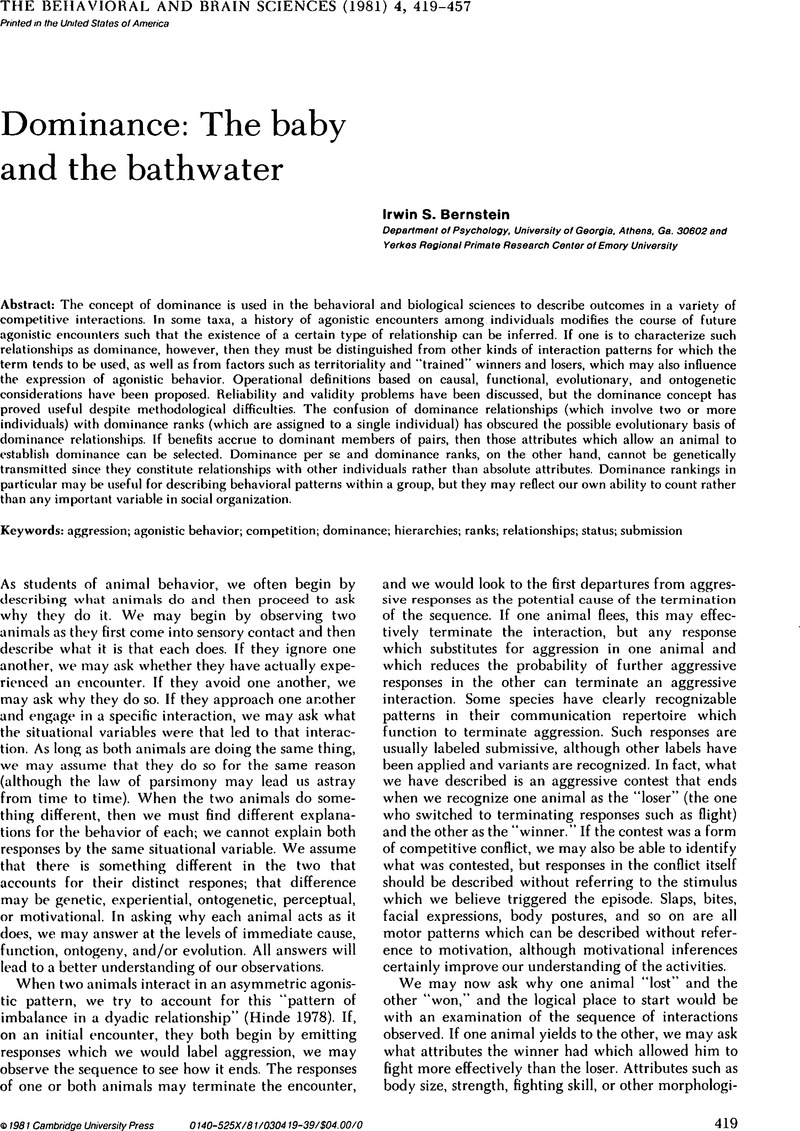Crossref Citations
This article has been cited by the following publications. This list is generated based on data provided by Crossref.
Bernstein, Irwin
1983.
Agreements on dominance!.
Behavioral and Brain Sciences,
Vol. 6,
Issue. 2,
p.
338.
Mckenna, James J.
1983.
The dominance concept: We agree more than we realize.
Behavioral and Brain Sciences,
Vol. 6,
Issue. 2,
p.
335.
Barnett, S. A.
1983.
Dominance: An empirical finding or a platonic idea?.
Behavioral and Brain Sciences,
Vol. 6,
Issue. 2,
p.
334.
Rosenblum, Leonard A.
and
Schwartz, Gary G.
1983.
Dominance: Strategy is the name of the game.
Behavioral and Brain Sciences,
Vol. 6,
Issue. 2,
p.
337.
Ursin, Holger
and
Myhre, Grete
1983.
Instrumental effects of agonistic behavior.
Behavioral and Brain Sciences,
Vol. 6,
Issue. 2,
p.
338.
Delgado, José M. R.
1983.
Dominance, hierarchy, and brain stimulation.
Behavioral and Brain Sciences,
Vol. 6,
Issue. 2,
p.
334.
1985.
Social and non-social knowledge in vervet monkeys.
Philosophical Transactions of the Royal Society of London. B, Biological Sciences,
Vol. 308,
Issue. 1135,
p.
187.
Chase, Ivan D.
1985.
The sequential analysis of aggressive acts during hierarchy formation: an application of the ‘jigsaw puzzle’ approach.
Animal Behaviour,
Vol. 33,
Issue. 1,
p.
86.
Chase, Ivan D.
and
Rohwer, Sievert
1987.
Two methods for quantifying the development of dominance hierarchies in large groups with applications to Harris' sparrows.
Animal Behaviour,
Vol. 35,
Issue. 4,
p.
1113.
Ray Stricklin, W.
and
Mench, Joy A.
1987.
Social Organization.
Veterinary Clinics of North America: Food Animal Practice,
Vol. 3,
Issue. 2,
p.
307.
Rhine, Ramon J.
Cox, Roberta L.
and
Costello, Michael B.
1989.
A twenty‐year study of long‐term and temporary dominance relations among stumptailed macaques (Macaca arctoides).
American Journal of Primatology,
Vol. 19,
Issue. 2,
p.
69.
Hemelrijk, Charlotte K.
and
Ek, Anneke
1991.
Reciprocity and interchange of grooming and ‘support’ in captive chimpanzees.
Animal Behaviour,
Vol. 41,
Issue. 6,
p.
923.
Janus, Magdalena
1992.
Interplay between various aspects in social relationships of young rhesus monkeys: Dominance, agonistic help, and affiliation.
American Journal of Primatology,
Vol. 26,
Issue. 4,
p.
291.
Aureli, Filippo
Cozzolino, Roberto
Cordischi, Carla
and
Scucchi, Stefano
1992.
Kin-oriented redirection among Japanese macaques: an expression of a revenge system?.
Animal Behaviour,
Vol. 44,
Issue. ,
p.
283.
CUMMINS, DENISE DELLAROSA
1996.
Evidence for the Innateness of Deontic Reasoning.
Mind & Language,
Vol. 11,
Issue. 2,
p.
160.
Engh, Anne L.
Esch, Katrina
Smale, Laura
and
Holekamp, Kay E.
2000.
Mechanisms of maternal rank ‘inheritance’ in the spotted hyaena, Crocuta crocuta.
Animal Behaviour,
Vol. 60,
Issue. 3,
p.
323.
Hewitson, Lindsey
Gordon, Iain J.
and
Dumont, Bertrand
2007.
Social context affects patch-leaving decisions of sheep in a variable environment.
Animal Behaviour,
Vol. 74,
Issue. 2,
p.
239.
Puga-Gonzalez, Ivan
Hildenbrandt, Hanno
Hemelrijk, Charlotte K.
and
Friston, Karl J.
2009.
Emergent Patterns of Social Affiliation in Primates, a Model.
PLoS Computational Biology,
Vol. 5,
Issue. 12,
p.
e1000630.
Stern, David I.
2014.
High-Ranked Social Science Journal Articles Can Be Identified from Early Citation Information.
SSRN Electronic Journal,
2014.
Free‐Ranging Cats.
p.
251.



